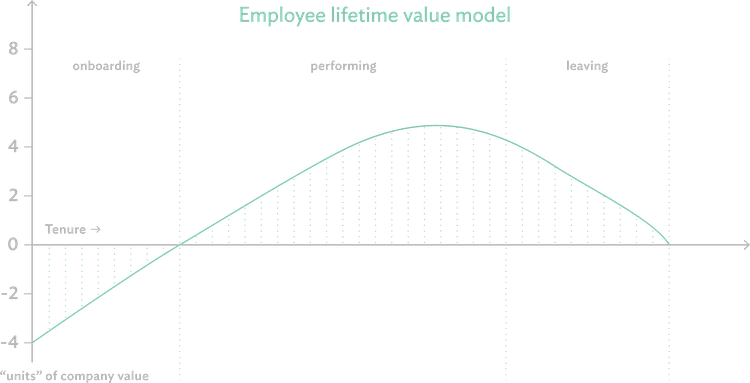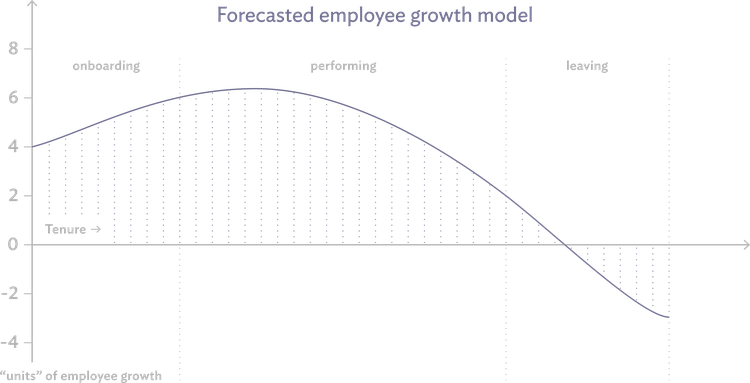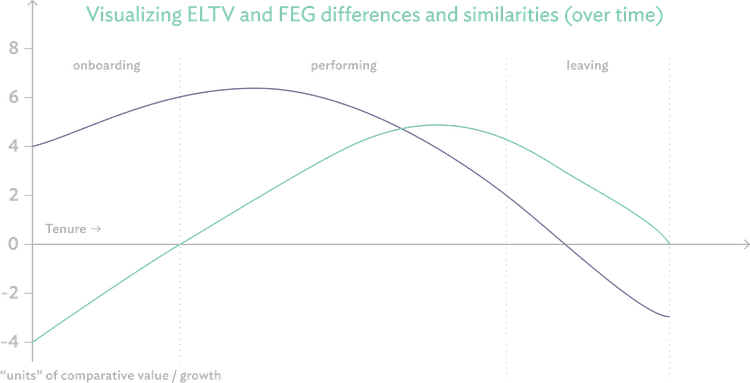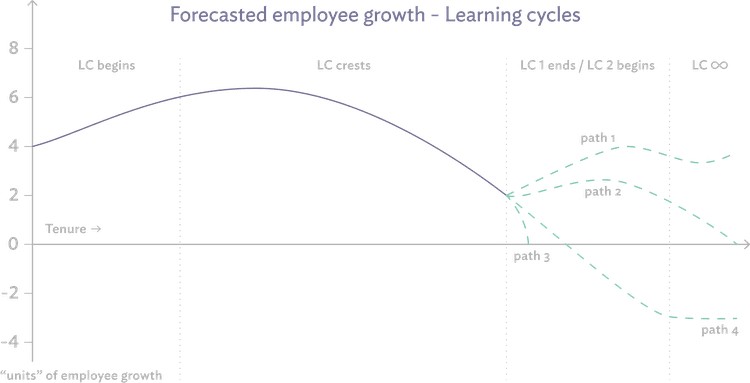
Article
Written by

Former Head of Diversity & Inclusion
The concept of Employee Lifetime Value (ELTV) articulates how companies can measure the ROI of modern people practices. ELTV provides us with a roadmap on how human resources, traditionally thought of as an “overhead” function, can meaningfully contribute to the bottom line. It’s beautifully simple in the way it showcases the value of people practices.
But like any singular measure, ELTV can be misinterpreted. As someone on the front lines of the People Analytics movement, I want to address the shortcomings of the ELTV model and introduce a new model that measures employee growth.
People analytics is a powerful tool that brings quantitative methods, research, and discipline to a field that is far behind in analytical capability. As the industry starts to mature, the metrics we define today determine the focus and trajectory of the future. If you want to truly drive ELTV, you have to break free of the model itself and understand what actually drives it rather than just measuring it. I encourage HR leaders to consider modeling ELTV alongside another metric to measure how much an employee experiences growth, which I call Forecasted Employee Growth (FEG).
If companies consider Forecasted Employee Growth, I believe they maximize ELTV in the long run while enabling employees to reach their highest potential.
This is Employee Lifetime Value, measured in units of an individual’s value to the company

This is Forecasted Employee Growth, measured in units of an individual’s personal growth

Here, we see ELTV and FEG together. The green line plots ELTV; the purple line plots Forecasted Employee Growth (FEG). By plotting these graphs on top of each other, we begin to see the tug-of-war between these two models over the same time frame.

It is convenient to think of onboarding, performing, and leaving as the beginning, middle, and end of the employee lifecycle. But in practice, the employee-employer relationship is not so simple. There can be multiple cycles of onboarding and performing, creating “learning cycles” throughout an employee's tenure at the company as they move between roles. A learning cycle is a period of time where an employee, their manager, and the company are in agreement on what is expected from the individual employee. The concept of a learning cycle is similar to “tours of duty” popularized by Reid Hoffman in The Alliance. The FEG model assumes there can be many learning cycles throughout an employee’s tenure, as long as all parties are in alignment. Next, we'll explore differences and similarities between these two models, to understand how they work together.
Difference. At the beginning of someone's tenure, ELTV is negative - they are using company resources and have yet to contribute measurable value. But from the individual's perspective, this period is full of growth and learning. They are forming new networks, adapting to a different business perspective, and facing new challenges. Our New Tech Benchmark report shows that employee engagement is highest in a person's first three months of employment.
Similarity. An employer's attempts to shorten ramp-up time benefits them and the employee. Both ELTV and FEG move hand-in-hand from effective employee onboarding. As an employee approaches full productivity, both the individual and the company are set to gain.
Difference. The biggest difference is when ELTV is at its highest peak because FEG has already started to decline. Employers are extracting maximum value out of an employee when they can do tasks without supervision. From an individual perspective, growth is certainly achieved when this state is reached. However, the rate of growth is hindered when past challenges start to become mundane. Our own data suggests that this is the case: engagement between the first and second years of tenure starts to drop, and lack of learning and development is usually a major contributing factor. An employer might be tempted to keep the employee in this role and function, especially if the ELTV model suggests that the company is profiting.
Similarity. By the time someone's ELTV is waning, their FEG is also declining. While this period isn't the best for the employee or company, both parties are still above the x-axis. That is, the employee is still learning and the company is still receiving value - it's just that these are both moving downwards.
Difference. The tail end of the ELTV model shows declining company value as someone makes the decision to leave. However, this decrease in output doesn't occur once the individual decides to leave, as ELTV suggests. Output actually decreases at the point during which the employee becomes disengaged. There is a high opportunity cost when the employee could be experiencing challenges in a different role, team, or company. The opportunity cost also exists for the company if someone else could be producing higher value. From an ELTV perspective, a company might attempt to retain the employee at the expense of that employee's personal growth; this is not the case when applying forecasted employee growth.
Similarity. Employers know that investing in learning and development opportunities can improve ELTV and FEG simultaneously. No matter the position of ELTV or FEG curves, an environment of constant learning will have an impact on improving employee value and personal growth.
The ELTV model validates the priorities of an HR function but ignores the growth of individual employees. Perhaps it should come as no surprise that median tenure has been steadily declining if we're not putting people first. That's where Forecasted Employee Growth (FEG) comes in. Using this model, we can forecast the growth that individuals will achieve in their roles.

As a reminder, a learning cycle is a period of time where an employee, their manager, and the company are in agreement on what is expected from the individual employee. There can be many learning cycles, and we'll explore these along with four ways a learning cycle comes to a close.
Consider how to increase an individual's amount of growth during the onboarding period through the following:
This period evaluates an individual's growth from when onboarding ends, through full productivity and learning, and into its decline. In this stage, it is advantageous to start planning the next learning cycle (before the employee is making the decision to leave). You can maximize FEG in this stage through:
It is critical to establish when a learning cycle is coming to a close. A rule of thumb is to recognize when someone's growth dips below their initial level of learning. This moment is inevitable, although when it happens depends on the individual, the company, the role, and even outside factors.
To increase FEG, you need to recognize when the learning cycle is ending. This can be done by:
This is the most ideal growth path because it is driven mutually by the company and its employees. Recognizing that growth is starting to decline, the employer can promote growth through a new business opportunity, internal mobility, promotion, formal training, or access to a mentor. The employee should proactively seek out any of the above opportunities or create their own. When both parties are committed to the next phase of the individual's growth, a new Learning Cycle begins. Each learning cycle has the ability to crest higher than the ones before. These learning cycles can continue indefinitely, as indicated in the model.
This is the growth path that many employees are on today. It is most commonly a result of L&D programs that look to maximize ELTV but do not consider individual growth perspectives. When an employer surfaces growth opportunities that benefit the company, but don't consider the individual, then the individual isn't maximizing growth.
The other side of the coin is that an employee wants growth, but the company does not provide the right environment for these opportunities. In this situation, there might be a temporary bump in growth, but the Learning Cycle is stunted when employer and employee are out of sync.
This is a path that many people are afraid to acknowledge as a viable option - the end of employment. In this case, the company does not possess the right kind of growth opportunities that an individual is searching for. The employee may not see a path for continued growth at the organization. An effective manager should be able to facilitate this conversation and help the employee pursue a new avenue of growth by ending employment at the company.
An n individual's career path and perspectives change the same way a company’s priorities change over time. If growth is not achievable, a progressive company may even help someone achieve personal growth by assisting in finding their next role outside the company. A true FEG model believer sees the person as a human first and an employee second.
This is the worst path for the employee as employment continues but the employee is disengaged.
The company may still be receiving some value (per the ELTV model), but FEG is negative because there is an opportunity cost of having someone in that role. The employee may be subject to forces outside the workplace that might encourage them to stay in a job where their learning is stifled. For example, if the individual has a compensation or equity package that encourages them to stay longer, even though they might not be putting in discretionary effort. This results in a prolonged situation in which neither party is willing to have a frank conversation about growth. An individual can continue on path #4, experiencing no growth, indefinitely.
My theory is that when companies apply a lens of FEG, they will maximize ELTV in the long run. They will also achieve better business success, engagement, and employee happiness. Traditional human capital metrics may be easy to measure, but they are measuring the wrong outcome. In an employee-centric world, we have to consider both ELTV and FEG together.
I believe that the purpose of People teams is to provide every individual the ability to reach the highlights of their career. We have the power to enable individuals to achieve the personal and professional accomplishments that define their lives. We set policies that determine when people start families, give them the resources to take care of loved ones, and build relationships inside and outside the office. Companies, their leaders, and by extension, their People Teams, have an obligation to maximize an individual's growth. By using the forecasted employee growth model, they can begin to meet this obligation.